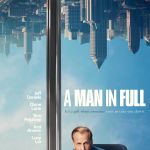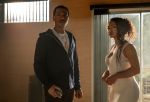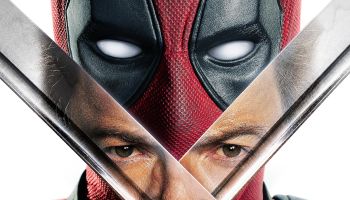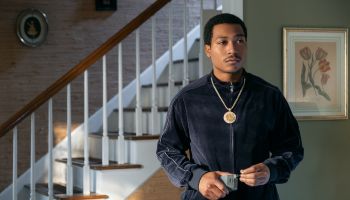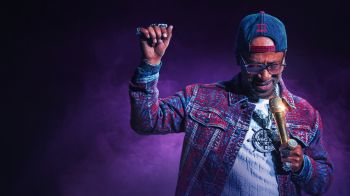“Back In the Days: Remix” by Jamel Shabazz is an update on the seminal hip-hop photography book “Back In The Days” by Jamel Shabazz, a Red Hook, Brooklyn native, former Corrections officer and US Serviceman.
First Published in 2001 Shabazz’s “Days” captured a generation of styles, fashion and lives of strangers and friends during the 1980s.If you love hip-hop and you don’t have a copy of the 2001 powerHouse published book, then you’re not a hip-hop lover.
GlobalGrind spoke to Shabazz by email about the impact of his book and about what to expect from the new updated version out now.
GlobalGrind: Much has occurred since “Back In The Days” launched 10 years ago. You became famous, you traveled a lot, you published other books and so on. “Back In The Days” became an archetype that defined a culture, serving as a device that reignited memories of people’s past. It also planted a desire for the past in people who were not there, namely young people.
Were you prepared, in any way, to receive the acclaim and fame that came with its publication or were you surprised by its reception?
Jamel Shabazz: I am extremely thankful for all the blessings that have come my way since the release of “Back In The Days.” I was by no means ready for all the attention that it garnered and it is still a very difficult situation for me to process today. With all honesty, I seek no fame and my only desire is to contribute to the preservation of world history and encourage the next generation of visual artists.
[pagebreak]
In the 10 years since its publication, photography went through many changes: the death of Polaroid, the saturation of digital photography via cameras and cell phones, the ubiquity and the demystification of self publishing etc. Are you still using film or did you switch to digital? If you are still using film, please tell our audience why.
I was given a Canon 5D back in 2008 and instantly fell in love with it. What I enjoyed most about this new phenomenon was having the ability to show my subjects their images right away, along with uploading and emailing them as well. On an average day I roll with two cameras, my 5D Mark 2 and my Contax G2 range finder which I still shoot black and white film with. I appreciate the results of both cameras and I plan to always shoot black and white film, just to keep with tradition and a classic feel.
What photographers, if any, are you looking at or interested in?
I just recently went to the home of legendary jazz photographer Chuck Stewart. During this visit he shared numerous stories about his life, from picking up the camera at thirteen to being in the army as a combat photographer during the Korean war. I was moved by both his incredible history along with his massive body of black and white images made over the past 60 years. Unbeknownst to many, he has photographed over two thousands album covers during his life; a true legend and icon! I also have great respect for documentary photographer Joseph Rodriguez. It was his book “Spanish Harlem” that gave me the inspiration to do “Back in the Days,” upon seeing it for the first time. Joe has not only been a wonderful mentor to me over the years, but I am also honored to call him a friend. I must also give homage to war photographers James Nacthaway and New York Times photographer Tyler Hicks. It is through their stunning images that we are able see the horror and brutality of war. I sincerely commend them both for using their talent and courage under some of the harshest conditions imaginable.
[pagebreak]
One of your many strengths as photographer is your connection to your community and to individuals. You always go back, you always remember a subject, their names, their experiences because they’ve let you into their lives for, sometimes, more than the few seconds it takes to photograph them. Where does this come from? Is this learned or is it innate?
My ability to both connect and communicate with the many people I photographed stems from my unconditional love for my people and humanity overall. I found that over the years of embracing that way of thinking, people pick up on your vibration and are more apt to allow you into their world.
The cornerstone of these relationships is firmly grounded in having knowledge of self and a clear understanding of my purpose in life.
We were at a party in NYC nearly a decade ago and heard you speak German to an eccentric German artist, a lady who was strong willed, pushy even. Please tell us how you learned German. Did you learn it while in the military? Please also talk about returning to Germany as a photographer. What was that like?
Believe or not, I learned how to speak a “little” German by watching World War II movies as a youth. The Rat Patrol and Hogans Hero’s were the main ones, but I also watched alot of documentaries on the war. I was amazed at how a so many English words were borrowed from the German language, so it made it somewhat easy to both translate and comprehend. Once I got stationed in Germany, I took the initiative to learn it properly. Although I never became fluent in it, I was at least able to conduct my daily business. I returned to Germany in 2005, this time as a civilian and an artist and stayed in Berlin for about a week. This experience was a serious culture shock seeing how Germany had changed over the years. From the Berlin Wall being torn down to the reduction of American military troops. What was most surprising was seeing young adults of mixed race that were not a product of West German women and American servicemen, but East German women and African students who met in the once communist East Germany.
[pagebreak]
Today you appear to be comfortable being photographed, whereas 10 years ago there was a mystery about the man behind the lens. We make this judgment based on documentaries we’ve seen you in as an expert and as a subject. What changed? What prompted you to show that part of yourself?
Despite how I appear, I am still not comfortable being in front of the lens. However, I agreed on certain occasions because I felt the need to share and address issues that I deemed were relevant.
What has been added to the new addition of “Back In The Days” and what’s been removed?
With the remix, two double page collages of color portraits were added to the front and back of the book, along with over thirty new images. There is also a great essay by Professor Cali Usher, who grew up in East Flatbush during the ’80s and who had a thorough knowledge of both the people and the culture of that era. Another noticeable change is that certain images that did not properly represent those that entrusted me with securing their legacy. [Some negative images] were removed and replaced with more positive images.
Any new projects we should be aware of?
I am presently working on a series of new self publishing projects. The first one, due out this fall, is called “Represent.” The photographs in this body of work reflects various aspects of my travels both here in the states and overseas. There are images from Morocco, Ethiopia, Sweden, France, Canada, Japan, Korea, Brazil, Italy, etc. Some of the groups that are represented are Bloods, Crips, graffiti artists, B boys, fraternity groups, Dj’s, photographers, and everyday people. I also wrote a compelling story that has the wings for an HBO mini series, based on my book “A Time Before Crack.” It is still a work in progress, but I am confident that this vision will come into fruition in the very near future.




